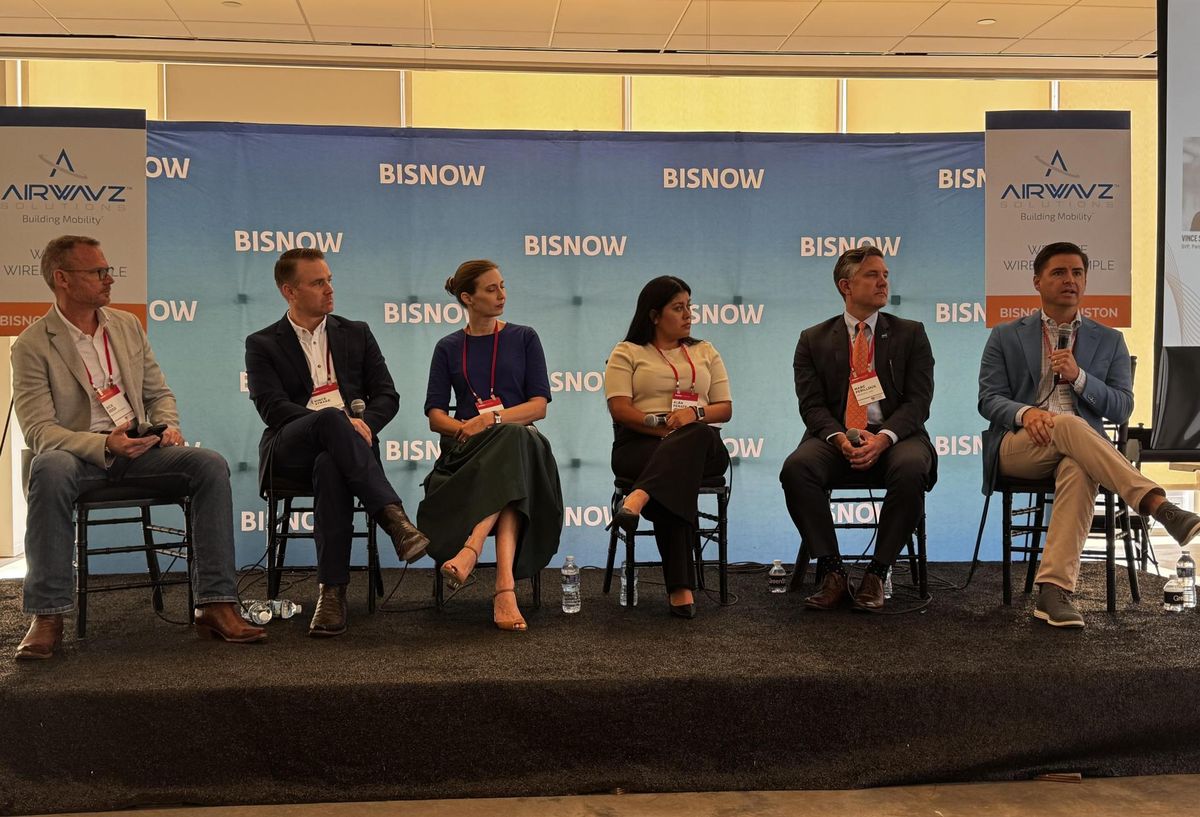A job candidate has never asked MetroNational President Scooter Hicks whether there is a coffee bar in the office lobby. That isn’t what matters.

Bisnow/Maddy McCarty
Boldyn Networks’ Rick Reed, Partners Real Estate’s Vince Strake, HOK’s Linnea Wingo, Sugar Land Office of Economic Development’s Alba Penate-Johnson, O’Donnell/Snider Construction’s Marc Perilloux and MetroNational’s Scooter Hicks.
Tenants also don’t really care about beanbags in the lobby, events or even free rent, Hicks said at Bisnow’s Houston Office Update event on Tuesday morning.
MetroNational’s Memorial City offices have thrived in recent years because they are close to many employees’ homes, making it easier for them to duck out at 5 p.m. and spend time with their families.
“We’ve done some incredible events in our common spaces at 4 o’clock on a Thursday, and you know, I’d be damned,” Hicks said. “We could put the Rolling Stones out there, but families are going to want to go see their daughters’ dance recitals.”
Flight to high-quality office buildings has become the norm, and some amenities are a basic expectation. But Houston developers and landlords are now taking a deeper look at what tenants want in order to generate higher rents that keep up with inflation and increasing development costs, panelists said at the event at GreenStreet.
Although landlords have heavily focused on reinvention and activation of office spaces, MetroNational has office buildings that haven’t been renovated and are pulling rents of $35 per SF, above the average Class-A rental rate of $33 per SF in the second quarter, according to Partners Real Estate.
This revenue is imperative when development costs have surged since the pandemic. MetroNational is developing a mixed-use project and one of the buildings is office, Hicks said. Altogether, it will be about $750 per SF to build, he said. Prepandemic, those costs would have been closer to $400 or $450 per SF.
“It sucks to be a developer right now,” he said.
Newly developed office buildings will need rents in the mid-$60s per SF to pencil, Hicks said.
“And that’s taking a lower return on cost, at that, to take development risk,” he said. “So congratulations, you can go spend a boatload of money, get top-of-market rents and earn a lower yield for like triple the risk. Inflation has been pretty gnarly on everybody.”
Even office buildings that came at a relative deal will need above-average rents. MetroNational bought the former Marathon Oil headquarters at 990 Town and Country Blvd. for less than half of the $300M that Marathon spent on it, Hicks said. Still, the investment will need to generate rents in the high $40s or low $50s, he said.

Bisnow/Maddy McCarty
Transwestern’s Katy Gragg, Impex Capital Group’s David Flores, Reebes’ Tom Paterson, Dominus Commercial’s Stephen LaMure and Scarlet Capital’s Daniel Ron.
JLL is leading leasing efforts at 990, which Hicks said is on par with Texas Tower as the highest-quality office buildings in Houston and has already secured a couple of leases.
While West Houston is one of the most in-demand office markets in the country, tenants are also interested in office space in the Galleria area and Downtown, said Vince Strake, senior vice president of office agency leasing at Partners Real Estate.
“There are deals getting done,” Strake said.
His team has inked 120K SF in the last 12 months at Jones on Main and 200K SF at San Felipe Plaza.
Leasing activity depends on the quality and location of the building, but a Class-B-plus to Class-A building in a good location will eventually get leased up, he said.
“With the supply spigot being turned off, you are going to see some really large mark-to-market opportunities, 5-to-10-year-old buildings getting in the $40s net outside of Downtown,” Hicks said.
With a lack of new supply and more older, Class-C office stock being taken out of the inventory, Houston could run into a problem that would have been unfathomable five years ago, Dominus Commercial CEO Stephen LaMure said.
“I think that we’re going to run out of office space in Texas,” LaMure said, adding that’s not necessarily a popular view.
But continued population inflow and tenant demand could push up rental rates in the Class-B and even Class-C markets, he said.
“New construction will come along,” LaMure said. “But when you can buy a building for 70 bucks a foot, and somebody is going to build one next door for $550, you’re in a pretty good spot.”
Even with preleasing commitments, development isn’t for the faint of heart, Hicks said.
“If you have patient capital or a high tolerance for pain, congratulations, you can do a build-to-suit,” he said. “Otherwise, continue to buy buildings [and] enjoy the mark to market.”
